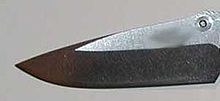
A knife is a tool or weapon with a cutting edge or blade, usually attached to a handle or hilt. One of the earliest tools used by humanity, knives appeared at least 2.5 million years ago, as evidenced by the Oldowan tools. Originally made of wood, bone, and stone, over the centuries, in step with improvements in both metallurgy and manufacturing, knife blades have been made from copper, bronze, iron, steel, ceramic, and titanium. Most modern knives have either fixed or folding blades; blade patterns and styles vary by maker and country of origin.

The kukri or khukuri is a type of short sword with a distinct recurve in its blade originated in the Indian subcontinent. It serves multiple purposes as a melee weapon and also as a regular cutting tool throughout most of South Asia. The kukri, khukri, and kukkri spellings are of Indian English origin, with the original Nepalese English spelling being khukuri.

A blade is the portion of a tool, weapon, or machine with an edge that is designed to puncture, chop, slice or scrape surfaces or materials. Blades are typically made from materials that are harder than those they are to be used on. Historically, humans have made blades from flaking stones such as flint or obsidian, and from various metal such as copper, bronze and iron. Modern blades are often made of steel or ceramic. Blades are one of humanity's oldest tools, and continue to be used for combat, food preparation, and other purposes.

A Bowie knife is a pattern of fixed-blade fighting knife created by Rezin Bowie in the early 19th century for his brother Jim Bowie, who had become famous for his use of a large knife at a duel known as the Sandbar Fight.

A blade's grind is its cross-sectional shape in a plane normal to the edge. Grind differs from blade profile, which is the blade's cross-sectional shape in the plane containing the blade's edge and the centre contour of the blade's back. The grind of a blade should not be confused with the bevel forming the sharpened edge; it more usually describes the overall cross-section of the blade, not inclusive of the beveled cutting edge which is typically of a different, less acute angle as the bevel ground onto the blade to give it a cross-sectional shape. For example, the famous Buck 110 hunting knife has a "hollow ground" blade, with concave blade faces, but the cutting edge itself is a simple, flat-ground bevel of lesser angle. It would be difficult, if not impossible, to put a "hollow grind" onto the actual cutting edge of the blade itself, which is a very narrow and small bevel.
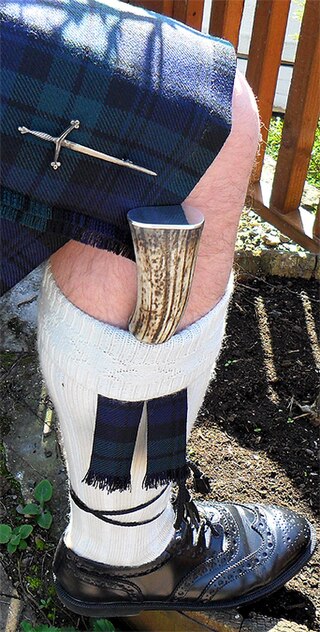
The sgian-dubh – also anglicized as skene-dhu – is a small, single-edged knife worn as part of traditional Scottish Highland dress along with the kilt. Originally used for eating and preparing fruit, meat, and cutting bread and cheese, as well as serving for other more general day-to-day uses such as cutting material and protection, it is now worn as part of traditional Scottish dress tucked into the top of the kilt hose with only the upper portion of the hilt visible. The sgian-dubh is normally worn on the same side as the dominant hand.
A puukko is a small traditional Finnish general purpose belt knife with a single curved cutting edge, solid hidden tang and, usually, a flat spine. Military models of puukko were popular in the Russian criminal underworld under the name "Finnish knife" or finka since the 20th century. The modified version were among the models on which the Soviet military knife NR-40 was based and which was informally called "finka".
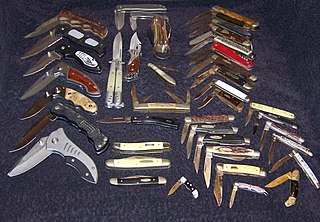
A pocketknife is a knife with one or more blades that fold into the handle. They are also known as jackknives (jack-knife), folding knives, EDC knife, or may be referred to as a penknife, though a penknife may also be a specific kind of pocketknife. Blade lengths typically range from 5 to 15 centimetres. Some pocketknives have multiple tools in addition to one or more blades.

The butterfly sword is a short dao, or single-edged sword, originally from southern China, though it has also seen use in the north. It is thought that butterfly swords date from the early 19th century. Several English language accounts from the 1840s describe local militia in Guangdong being trained in the "double swords", short swords with a hook extending from the guard, and fitting into a single scabbard.

A kitchen knife is any knife that is intended to be used in food preparation. While much of this work can be accomplished with a few general-purpose knives – notably a large chef's knife, a tough cleaver, a small paring knife and some sort of serrated blade – there are also many specialized knives that are designed for specific tasks. Kitchen knives can be made from several different materials.

The Santoku bōchō or Bunka bōchō (文化包丁) is a general-purpose kitchen knife originating in Japan. Its blade is typically between 13 and 20 cm long, and has a flat edge and a sheepsfoot blade that curves down an angle approaching 60 degrees at the point. The term Santoku may refer to the wide variety of ingredients that the knife can handle: meat, fish and vegetables, or to the tasks it can perform: slicing, chopping and dicing, either interpretation indicating a multi-use, general-purpose kitchen knife. The Santoku's blade and handle are designed to work in harmony by matching the blade's width and weight to the weight of the tang and the handle.

Survival knives are knives intended for survival purposes in a wilderness environment, often in an emergency when the user has lost most of their main equipment. Most military aviation units issue some kind of survival knife to their pilots in case their aircraft are shot down behind enemy lines and the crew needs tools to facilitate their survival, escape, and rescue. Survival knives can be used for trapping, skinning, wood cutting, wood carving, and other uses. Hunters, hikers, and outdoor sport enthusiasts use survival knives. Some survival knives are heavy-bladed and thick. Other survival knives are lightweight or fold in order to save weight and bulk as part of a larger survival kit. Their functions often include serving as a hunting knife. Features, such as hollow handles, that could be used as storage space for matches or similar small items, began gaining popularity in the 1980s. Custom or semi-custom makers such as Americans Jimmy Lile, Bo Randall, and Chris Reeve are often credited with inventing those features.

Ernest R. Emerson is an American custom knifemaker, martial artist, and edged-weapons expert. Originally an engineer and machinist in the aerospace industry, Emerson became a knifemaker by producing knives for a martial arts class and making art knives early in his knifemaking career. In the 1980s he became better known for his combat knives and popularizing a style of knife known as the Tactical-folder.

A hunting knife is a knife used during hunting for preparing the game to be used as food: skinning the animal and cutting up the meat. It is different from the hunting dagger which was traditionally used to kill wild game.

The clip point is one of the three most common knife blade shapes used. Clip point blades have the appearance of having the forward third of the blade "clipped" off. The clip itself can be straight or concave.
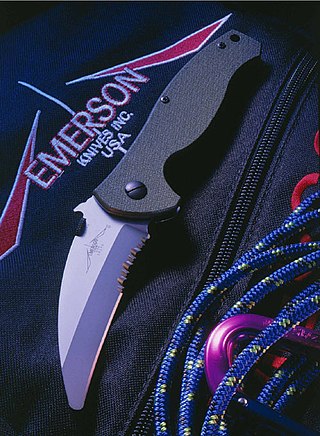
The SARK or NSAR is a folding knife designed by knifemaker Ernest Emerson for use as a search and rescue knife by the US military. It has a hawkbill with a blunt tip in order to cut free trapped victims without cutting them in the process. There is a variant with a pointed-tip designed for police, known as the P-SARK.
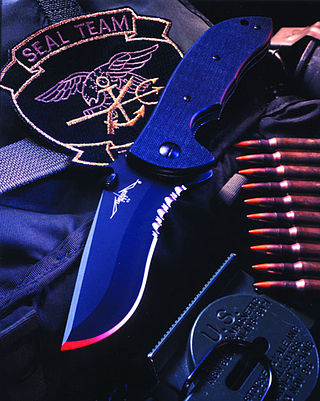
The Commander (knife) is a large recurve folding knife made by Emerson Knives, Inc. that was based on a custom design, the ES1-M, by Ernest Emerson that he originally built for a West Coast Navy SEAL Team. It was winner of the Blade Magazine Overall Knife of the Year Award for 1999.

A fillet knife is a kitchen knife used for filleting. It gives good control and aids in filleting. It is a very flexible member of the boning knife family that is used to filet and prepare fish. Fillet knife blades are typically 15 to 28 cm long. This allows them to move easily along the backbone and under the skin of meat.
James Buel Lile, known as Jimmy Lile and "The Arkansas Knifesmith", was an American knifemaker from Russellville in Pope County, Arkansas, who made the Rambo Knife for the films First Blood and Rambo: First Blood Part II. As a knifemaker Lile served as a president of the Knifemakers' Guild and on the board of directors of the American Bladesmith Society.
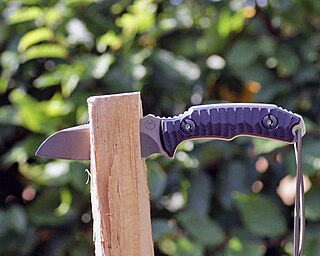
Batoning is the technique of cutting or splitting wood by using a baton-sized stick or mallet to repeatedly strike the spine of a sturdy knife, chisel or blade in order to drive it through wood, similar to how a froe is used. The batoning method can be used to make kindling or desired forms such as boards, slats or notches. The practice is most useful for obtaining dry wood from the inside of logs for the purpose of fire making.
